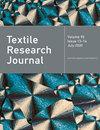Thermal behavior of flexible and breathable sandwich fibrous polyethylene glycol (PEG) encapsulations
IF 1.9
4区 工程技术
Q2 MATERIALS SCIENCE, TEXTILES
引用次数: 0
Abstract
Textiles incorporating phase change material have attracted increasing attention due to their temperature regulating function. Although a great progress has been made in the development of phase change material textiles, it has been found that the loading amount of phase change materials is limited by other final properties. Recently, we have proposed a sandwich fibrous phase change material encapsulation with a relatively high phase change material loading amount, which is a multi-layer fabric structure containing phase change material. However, the breathability of sandwich fibrous phase change material encapsulation should be improved because there is no path for air to penetrate through. In this work, the sandwich fibrous phase change material encapsulation structure with polyethylene glycol as phase change material is modified by introducing different air pockets in the thermal function layer ranging from 19% to 64%. The leakage phenomenon, phase transition behavior, thermal energy storage, breathability, T-history and practicality of the breathable sandwich fibrous phase change material encapsulations are investigated. As a result, the maximum polyethylene glycol loading amount of the phase change materials pocket is 83 wt%, and there is no leakage of polyethylene glycol during working time. The overall enthalpy value of the breathable sandwich fibrous phase change material encapsulation ranges from 27 J/g to 48 J/g. The optimal air permeability and water vapor resistance of the breathable sandwich fibrous phase change material encapsulation is 9 mm/s under 100 Pa and 34.5 m柔性透气夹心聚乙二醇(PEG)纤维包合物的热行为
含有相变材料的纺织品因其温度调节功能而日益受到关注。尽管相变材料纺织品的开发取得了很大进展,但人们发现相变材料的负载量受到其他最终性能的限制。最近,我们提出了一种相变材料负载量相对较高的夹层纤维相变材料封装,这是一种含有相变材料的多层织物结构。然而,夹层纤维相变材料封装的透气性有待提高,因为没有空气渗透的路径。在这项研究中,以聚乙二醇为相变材料的夹层纤维相变材料封装结构通过在热功能层中引入 19% 至 64% 的不同气孔进行了改良。研究了透气夹层纤维相变材料封装结构的泄漏现象、相变行为、热能储存、透气性、T 历史和实用性。结果表明,相变材料袋中聚乙二醇的最大装载量为 83 wt%,工作时聚乙二醇无泄漏。透气夹层纤维相变材料封装的整体焓值范围为 27 J/g 至 48 J/g。透气夹层纤维相变材料封装的最佳透气性和抗水蒸气性能分别为 100 Pa 下 9 mm/s 和 34.5 m2 Pa W-1。此外,由于混合热功能层的热阻复杂,通过透气夹心纤维相变材料封装层的异质传热也被发现。此外,透气夹层纤维相变材料封装还具有柔韧性、疏水性、自洁性、耐磨性和浸水后的稳定性。我们相信,这项研究在与相变材料有关的各种应用中具有巨大潜力。
本文章由计算机程序翻译,如有差异,请以英文原文为准。
求助全文
约1分钟内获得全文
求助全文
来源期刊

Textile Research Journal
工程技术-材料科学:纺织
CiteScore
4.00
自引率
21.70%
发文量
309
审稿时长
1.5 months
期刊介绍:
The Textile Research Journal is the leading peer reviewed Journal for textile research. It is devoted to the dissemination of fundamental, theoretical and applied scientific knowledge in materials, chemistry, manufacture and system sciences related to fibers, fibrous assemblies and textiles. The Journal serves authors and subscribers worldwide, and it is selective in accepting contributions on the basis of merit, novelty and originality.
 求助内容:
求助内容: 应助结果提醒方式:
应助结果提醒方式:


